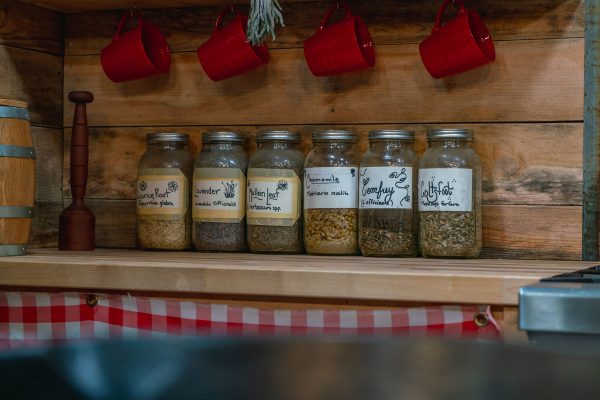











Learn everything you need to know about raising meat chickens. From their needs as baby chicks to chicken tractors, all the way to butchering day and processing them for long-term storage.
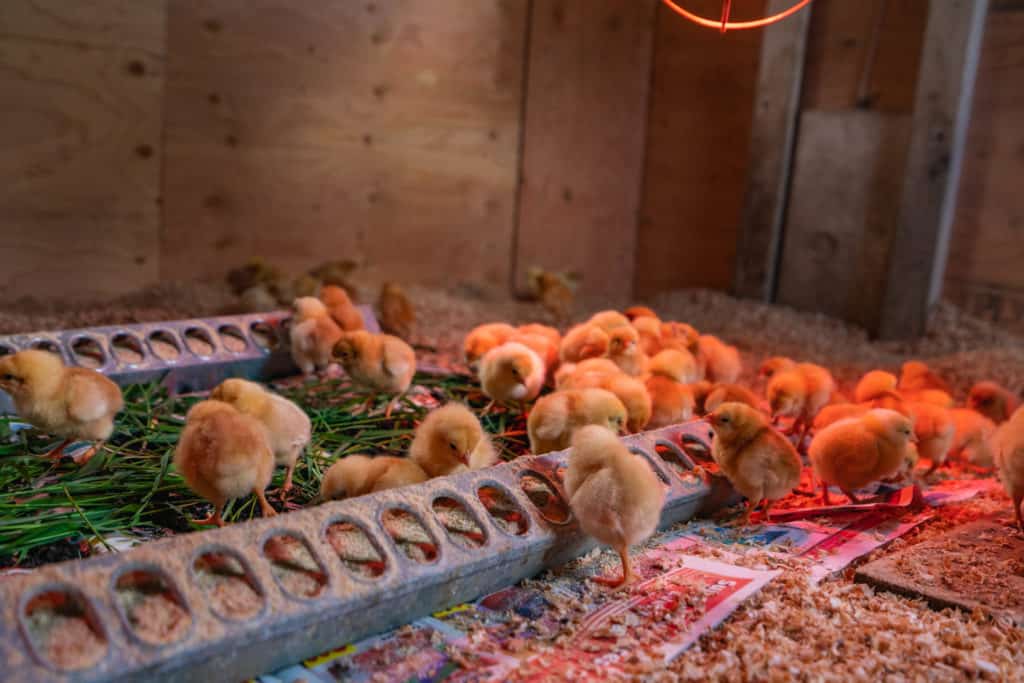
Just like raising meat rabbits, raising meat chickens is a great step toward becoming self-sustainable, building up a well-stocked pantry and food supply, plus you may be surprised at just how many meat chicks you can raise in a short amount of time to fill your freezer with healthy, free-range chicken.
We’re often asked how to raise a year’s worth of meat, and how much land does it take to raise a year’s worth of meat (that answer may surprise you!). This blog post will break down what to expect with your meat chickens from day one, as well as more information on how to choose a breed, when to order and when to butcher.
The newest video (below) shows how we raise broiler chickens from the day we receive them all the way to the dinner table. It’s a beautiful reflection of why we do what we do and the genuine care our animals receive.

What Breed is Best?
What breed is best for one may not be the best breed for another. Here are some of the breeds we’ve raised and what we’ve settled on based on how quickly they grow, their taste, the overall health of the birds and their size.
- Red Ranger – Red Rangers have been our preferred breed for many years (and are what we show in the videos below). They are healthy and hearty, take a moderate amount of time to grow and are great free-rangers. They will grow to about 5-6 lbs in size and take about 9-11 weeks until ready for butchering. The cons are they’re not as fast-growing as the Cornish Cross, and they don’t have quite as much breast meat.
- White Ranger – We recently switched to raising White Ranger chickens (a newer breed). White Rangers have the same great qualities as the Red Rangers, but they pluck better, grow faster (about 7-9 weeks) and still have the same great flavor as the Red Rangers.
- Cornish Cross – The Cornish Cross breed is a large, fast-growing and big-breasted bird. It will grow to about 4-5 lbs in size and take about 6-8 weeks until ready for butchering. Those are about the only positives (in our opinion) about this bird. The cons are that the birds are quite weak. Many die either in transport or shortly after they get in the brood coop. They are also pretty flavorless, in our opinion, and are closer in taste to a chicken you’d get from the grocery store.
- Heavy or Dual-Purpose – The heavy or dual-purpose chickens are those that work for both meat chickens and egg-laying chickens. These are great if you don’t want to bother with different breeds and if you aren’t sure yet what you want the chicken for (meat or egg production). These chickens will grow to about 5 lbs in size in about 16-20 weeks. They’re the slowest-growing out of the three, but they do have a great flavor and tend to be very healthy. The cons of this variety are because they’re slow-growing, you end up spending more on feed (they’ll cost more in the end) and they tend to have a smaller breast size.
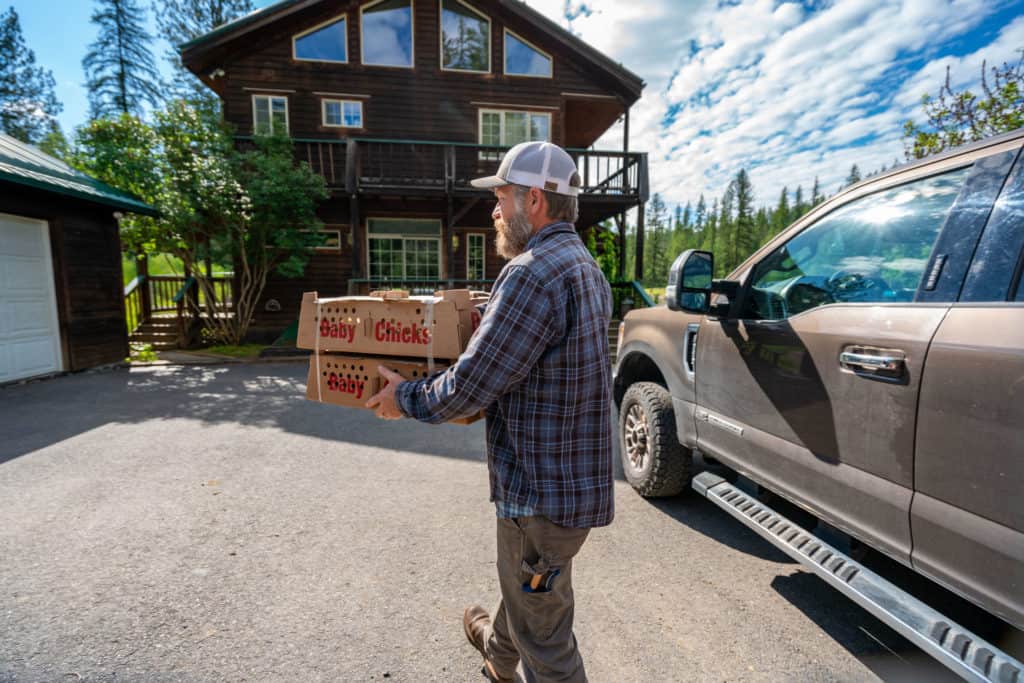
When to Get Meat Chickens
What is Your Plan?
Knowing when to start (or when to order) your meat chickens varies greatly depending on where you live and what your plans for butchering day look like.
Many people start them very early in the season (which is early Spring), but if you live in a colder area like us, this can be very hard on the chicks and survival rates may drop.
If you’re not a commercial grower and you’re just raising meat chickens for yourself then there’s no need to rush the process. Wait to get them until the temperatures are more cooperative.

Consider the Temperatures
We get our meat chicks delivered in mid-June so the weather is nice and warm (but not too hot or too cold). This warm weather doesn’t stress the birds out and allows them to adjust nicely to their new home.
You also want to consider the average temperatures during the longevity of the chickens life and the temperature during the week you plan on butchering.
If you live in a hot climate, getting them earlier or later in the season will be more ideal.
Consider whether there are typically any hot or cold spells that might interfere with their well-being. Will the weather still be extremely hot on butchering day? We like to plan it so it’s starting to cool off by the time we’re butchering.
Where to Buy Meat Chickens
We have purchased chickens from many different places. In fact, we used to buy them from a very well-known company, but we didn’t have a great survival rate.
We tried Freedom Ranger Hatchery a few years back and have been ordering from them ever since. We always have a great survival rate and the chicks come active, happy and healthy.
We spoke with the owner and were told that their stock is extremely limited this year, but we highly recommend looking into them for your next purchase.
We actually order our chicks in January and just schedule them to be delivered mid-June.
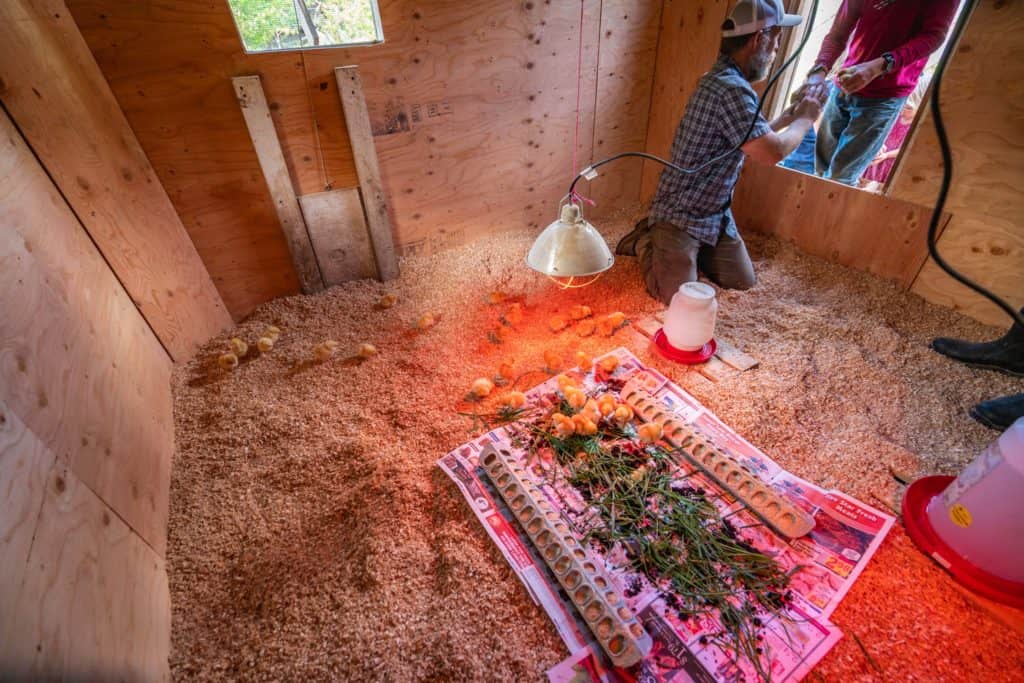
Bringing Meat Chicks Home
If you’ve ordered your chicks through the mail, or even if you’re bringing them home from the farm and garden store, you’ll want to be sure to protect them on the drive home.
Protect Chicks From Wind
Keep them in their box and keep them protected from the wind. Don’t stick them in the bed of your truck, or drive with the windows down where they’re getting windblown.
If need be, you can even cover the boxes with a blanket. Wind is a big enemy of baby chicks so it’s important to protect them right from the start.
Keep Chicks Level
As much as possible, try to keep the box level. You don’t want chicks piling up to one side of the box as this can smother and potentially kill them.
In my truck I use a blanket to prop the box up a bit.
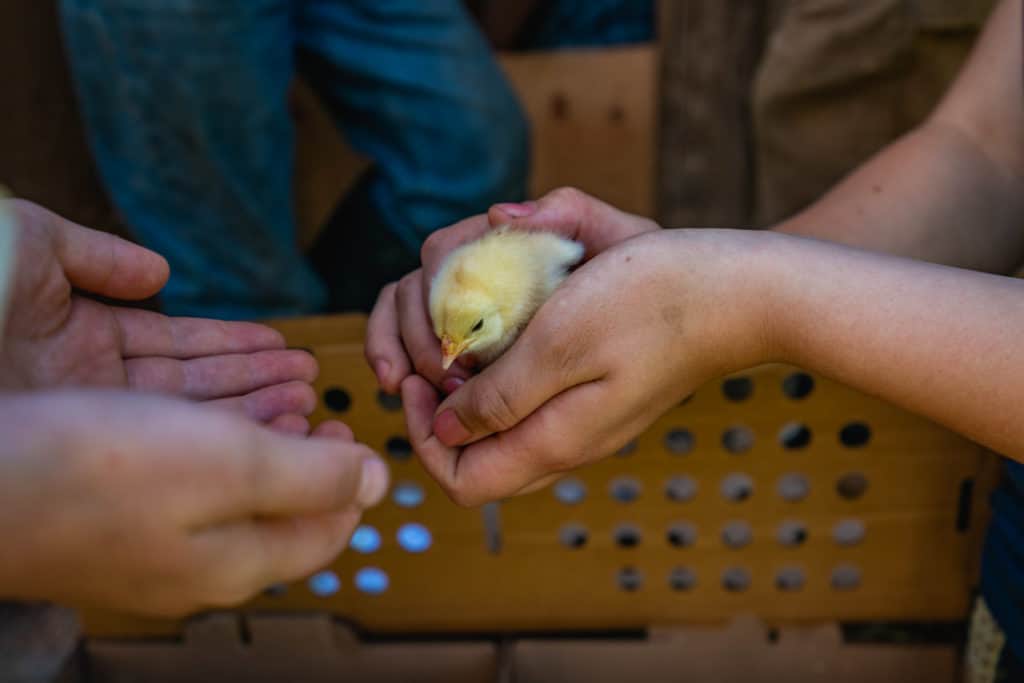
Don’t Handle Baby Chicks Too Much
At our house, baby chick arrival day is very exciting. All the kids want their turn holding and cuddling the baby chicks. But it’s not great for the birds to be handled too much right away.
They’ve had a stressful journey and need time to acclimate and adjust.
In order to let the kids see the baby chicks, we let each child take one chick and hand it into the brood coop, then they rotate until all the chicks are inside (we make sure the little kids have a big kid helper!).
Preparing a Brooder Coop
When we bring the chicks home, we settle them into their brood coop. They need food, water, heat, grit, grass, bugs, and bedding right away.
You don’t need an elaborate setup; we’ve even seen people use a kiddie pool with cardboard around the edges.
Be sure your coop doesn’t have any corners or places where the chicks can get lodged or stuck. We’ve found that chicks tend to get piled up and trampled in the corners, so we take an extra board and nail it in at an angle to eliminate 90-degree corners.
We also dip each chick’s beak into the water right when we put them into the coop so they know where the water is and that there’s water to drink. We’ve found this helps them rehydrate much faster, as they can locate the water container more quickly.
As each chick is getting its beak dipped, I also take inventory of how it moves and acts once I set it down. This is basically taking inventory and getting a good indication of their health, as well as spotting any chicks that might be having a difficult time.
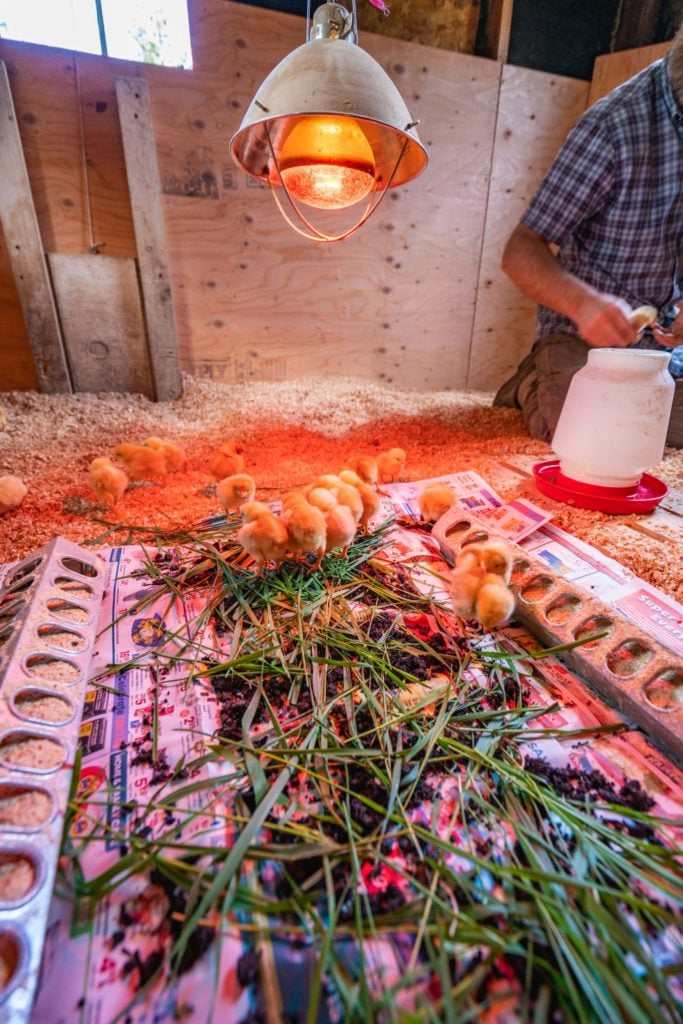
Baby Meat Chicks Needs
It’s important to have everything the baby chicks need BEFORE you get them home. As we mentioned above, you need a brood house filled with bedding, sun, wind and inclement weather protection, heat, food, water, grasses, grit, and bugs.
Bedding
We like to use wood chips that are finely shaved. Nothing too sharp or hard. A few inches will do. Depending on the size of your coop, you may need to replenish this from time to time as it gets dirty or strewn about.
Heat
When little, the chicks will need heat. Baby chicks usually spend up to a few weeks under the protection from their mama hen for warmth and shelter.
Have a heat lamp (or two or three, depending on the number of your chicks). We simply hang a heat lamp from the ceiling using some baling twine and a slip knot so it’s easily adjustable.
You’ll need to keep your eye on the chicks for the first couple of days to know if your lights are at the right height.
I start with the light about one foot off the ground. If the heat is too high, the chicks may start to pile up on each other trying to get to the warmth.
If the light is too low, the chicks will only gather near the edges of the heat lamp, meaning not all the chicks will be warm.
Adjust up or down as you observe the chick’s behavior.

Fresh Water
Be sure your water is set on a stable surface so it can’t be knocked over.
You’ll also want to be sure you have enough water for the number of chicks you’re raising. You’ll want enough space so that half of your chicks can be drinking water at the same time.
Many people suggest adding electrolytes to the water, which may also contain antibiotics as well. We used to do this, but once we switched to ordering from Freedom Ranger we found this to be unnecessary.
The chicks come really healthy, and we don’t find the need for electrolytes.

Food
As with the water, you want to make sure there is enough food and access to the food for your chicks. At least half the chicks should be able to eat at the same time.
As for what to feed them, you’ll want to give them a chick starter feed that has about 22% protein.
Grit, Grass & Bugs
Laying out a layer or two of newspaper, we like to add on top some grit (sandy soil), fresh grass clippings, and bugs.
This instantly makes the birds feel like they’re in their natural environment and gets them hunting and foraging right away. Also, the grit gets into their gizzards and keeps them healthy.
Ventilation & Protection from Weather
You have to keep your chicks protected, but they also need a good amount of fresh air circulation. You don’t want them in a stuffy environment, or an environment where they’ll be exposed to too much sun, wind, or rain.
Be sure to check on them multiple times throughout the first few days to be sure they have everything they need. That none of them are getting trampled or stuck and that they all have access to water and food.

More on Raising Meat Chickens
Be proactive. It’s a good idea to learn how to identify and treat common poultry diseases before an issue occurs and to learn how to ferment chicken feed to reduce feed costs while improving health.
For more information about raising meat chickens, including everything you need to know when building a chicken tractor, as well as tips and tricks for butchering day, watch the video below.
If you are thinking about buying a mobile coop instead of building one, you may want to read our Happy Farmer Mobile Chicken Coop Review.












